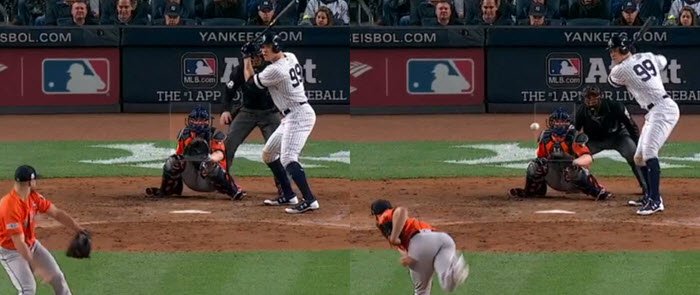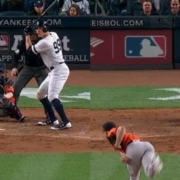Teach Kid To Hit For Power By Hitting Baseball Or Softball Better, Farther, & Harder With Catapult Loading System
Discover how to teach a kid to hit for power by hitting a baseball, fast pitch, and slow pitch softball better, farther, and harder with the Catapult Loading System.
Why I Teach Hitters To ‘Show Numbers’ (And Maybe You Should Too)
Question: How does ‘Showing Numbers’ to the Pitcher Effect Bat Speed at Impact versus ‘NOT Showing’ them?

Aaron Judge (Showing Numbers), unloads a solo home run to center field on 10/17/17 to put the Yankees on the board in the 7th inning.
Using the Zepp (Labs) Baseball app, I wanted to use the Scientific Method to analyze if a hitter showing their numbers to the pitcher at landing adds to or takes away from key swing performance metrics like Bat Speed at Impact, Time To Impact, and Attack Angle. This swing experiment is revisiting two other experiments done analyzing the same thing.
Background Research
Since we’re REVISITING two previous swing experiments on ‘Showing Numbers’ versus NOT, here are the original posts and data to get you up to speed:
- Want To ADD Between 25 to 40-Feet Of Batted Ball Distance?, and
- Buster Posey: ADD 6-mph To Bat Speed Using The Shoulders
In 2016 ‘Show Numbers’ swing experiment, this was what the averaged out Zepp data looked like:
- 5-mph INCREASE in Bat Speed at Impact with ‘Showing Numbers’,
- 0.5-mph INCREASE in Hand Speed Max with ‘Showing Numbers’,
- .003 second DECREASE in Time to Impact with ‘Showing Numbers’,
- 3* INCREASE in Bat Vertical Angle at Impact with ‘Showing Numbers’, and
- 1.5* INCREASE in Attack Angle with ‘Showing Numbers.
SCIENCE-BASED TRAINING:
Improve your hitting strategy dramatically by applying human movement principles.
Learn not only how and what to train but also the science behind the methods.
Now, let’s see how the Ball Exit Speed averages compare:
- 76.02-mph BES when ‘NOT Showing Numbers’,
- 77.32-mph BES when ‘Showing Numbers’,
- That’s a 1.3-mph average INCREASE when ‘Showing Numbers’, and
- Translates between 5.2-feet to 7.8-feet of EXTRA batted ball distance – depending on if you calculate using 1-mph BES = 4-feet of distance OR 1-mph BES = 6-feet of distance.
In this experiment, if you look at the ‘NOT Showing Numbers’ swings, they were actually ‘Showing Numbers’. In other words, the subject in the swing experiment, Preston Scott, already shows his numbers well causing a challenge to not show them. Therefore on the ‘Showing Numbers’ swings, he showed them more. I think that’s why we didn’t see as much of a difference in Ball Exit Speeds.
In 2014 ‘Show Numbers’ swing experiment, this was what the averaged out Zepp data looked like:
- Bat speed for NOT showing numbers at landing: 73-mph,
- Bat speed for showing numbers at landing: 79-mph (+6-mph),
- Highest bat speed for NOT showing numbers at landing: 82-mph,
- Highest bat speed for showing numbers at landing: 88-mph (+6-mph),
- Hand speed max for NOT showing numbers was: 27-mph, and
- Hand speed max for showing numbers was: 29-mph (+2-mph).
Between both swing experiments, we saw an average Bat Speed at Impact increase between 5 to 6-mph. In 2016 we saw a .003 second drop in Time To Impact ‘Showing Numbers’, while in 2014 we saw a .003 increase.
The research on increasing bat or ball exit speed can be seen in the following two books on springy fascia and spinal engine mechanics:
- Anatomy Trains
, by Thomas Myers, and
- The Spinal Engine
, by Dr. Serge Gracovetsky.
You can also get application of previously mentioned books through the following HPL video blog posts.
- Miguel Cabrera and the timing of torque.
- Josh Donaldson v. Jose Bautista: how spine engine mechanics are amplified by Gravitational Forces, and
- Adrian Gonzalez: how-to naturally spring load the body.
For those versed in Anatomy, for explosive movement on the Transverse Plane (twisting), there must be a protraction of the front scapula (‘showing numbers’), and a retraction of the back Scapula (what’s often referred to as ‘Scap Row’). Scap Rowing by itself doesn’t engage full range of springy fascia.
Hypothesis
Based on the above research, I’m expecting to see a dramatic bump in Bat Speed at Impact, Hand Speed Max, and possibly a reduction in Time To Impact. I think Attack Angle and Bat Vertical Angle at Impact will remain unchanged.
Showing Numbers Swing Experiment Part-3
Equipment Used:

This is the SwingAway Bryce Harper model hitting station used for the ‘Showing Numbers’ experiment.
- Zepp Baseball app (to measure Bat Speed, Hand Speed, Time to Impact, & Attack Angle),
- SwingAway Bryce Harper model hitting station,
- GS6 android phone to record swings, and
- 33 inch bamboo bat.
Setup:
- SwingAway Bryce Harper bungy suspended ball was set equal to the landing foot, and ball height was about knee height.
- I broke each swing down into three steps: 1) Get to landing, 2) Pause for 2-secs, and 3) Swing. The reason for this was to better control whether I was showing numbers or not.
- The two tests in the swing experiment were counter-balanced. Which consisted of eight blocks of 25-swings done in the following order ABBA BAAB. ‘Showing Numbers’ was letter ‘A’, and ‘NOT Showing Numbers’ was letter ‘B’. 200 total swings were completed in the experiment, 100 per test. Counter-balancing helps remove the “getting tired” and “warm up” factors.
- The ‘Showing Numbers’ swing shoulders were set to about 2’o’clock, if pitcher is 12’o’clock. The ‘NOT Showing Numbers’ swing shoulders were set to about 12’o’clock.
Data Collected from Zepp Baseball App:

Data Analysis & Conclusion
Zepp data analysis comparing the averages:
- Bat Speed at Impact INCREASE of 3-mph ‘Showing Numbers’,
- Hand Speed Max DECREASE of 1-mph ‘Showing Numbers’,
- Time To Impact INCREASE of 0.014 ‘Showing Numbers’,
- Bat Vertical Angle At Impact DECREASE of 4-degree ‘Showing Numbers’, and
- Attack Angle INCREASE of 6-degrees ‘Showing Numbers’.
The drop from previous ‘Showing Numbers’ swing experiments was surprising, in addition to a small 1-mph drop in Hand Speed Max. There was also a slight increase in Time To Impact. The interesting numbers were the ones that indicate Launch Angles, both Bat Vertical Angle at Impact and Attack Angle. We hadn’t experienced such a dramatic uptick in those in past experiments.
A couple notes…
- The past two experiments were done in a cage, off a tee, so I could see ball flight, and maybe that had an effect on the swing metrics.
- Some hitting coaches speak highly of Time To Impact and want to reduce at all cost, but I disagree. There’s a healthy range for that, you don’t want it too short or too long. I’m not going to get into why here, maybe in another post.
- To explain the dramatic increase of the barrel’s upward trajectory in ‘Showing Numbers’, I may have been getting more of a downward shoulder angle at landing.
- Protect Your Kid’s Future: Swing Mechanics to Prevent Career-Ending Injuries in Youth Baseball - September 7, 2024
- Unlock Advanced Swing Mechanics: How Engineers Use Physics to Boost Bat Speed and Efficiency - September 6, 2024
- Pitch Selection Mastery: How Groundball Hitters and Flyball Pitchers Are Quietly Reshaping MLB Strategy - August 22, 2024













Great article Joey…You so right… Showing your numbers should be multiplying your numbers….
Your absolutely correct regarding timing…Healthing range… Ill one up you… You teach substantial ( I’m not giving up on my pinch, grin and tighter coil) the high level swing with high level timing and distance… Shorter means your shortening the high level swing… Why the hell would you want to do that… if you shorten the high level swing you no longer have a high level swing…
Question… of Course I have a question ?
If the shoulders move into protraction… retractions… the shoulders are angled…. etc..
So what are there counter doing? What are the hips doing… Obviously the hips will have small distances because they are the big gear…
So if the hips and shoulders are making magic let’s continue down the lines… what are the feet and hands doing…
Well the feet are hard to see since there in the ground… and the hands are hard to see as they can move so much….
I just think this is interesting… And I think NEW INSTRUCTION should always mention the counter parts briefly… Obviously there are many parts that can be the counter so my idea isn’t perfect but by doing just a NOTICE eventually people will pick up or see the system better…
back to show me the numbers…I know I don’t show the numbers as much as you do and attribute that to a tighter coil and presetting the show me the numbers kind off… So for me you would see my hands out in front and a really fast scap load I guess with the show me the numbers…
I wonder if this affects power at all… part of me thinks it’s just mostly control and visual….Part of me thinks it’s power too…I guess my back elbow kind of pushes against by lead elbow as I start my “fighting hands”….
Maybe the fighting hands adds power but that only replacing the power from a “larger stretch”…
When I do it just like you I feel weaker and lose vision… I’m cross eye dominant….
It’s possible that because I have a tighter coil that perhaps a very small hip movement multiples much more with a tighter coil…
Actually the fact is I know I set my hips much more forward than you…My hips seem to be or feel like a really big gear… like I’m riding a ten speed and have it on the largest gear….
Obviously I’m not moving my hips but I’m noticing that when I swing… a little movement in the hips GOES a long way…. and I think it’s because of type of coil…
Something that never really occurred to me until our previous conversation…
So many questions…
~DM
By the way do you teach depression prior to showing me the numbers… as per my understanding I think depression and serratus anterior contraction would be part of the stacking prior to showing me the numbers…
It’s possible that you may not be doing those and as thus showing more of the numbers…
The magnitude of the show me the numbers has always striked me as a great area…
Amy thoughts would be appreciated…
~DM